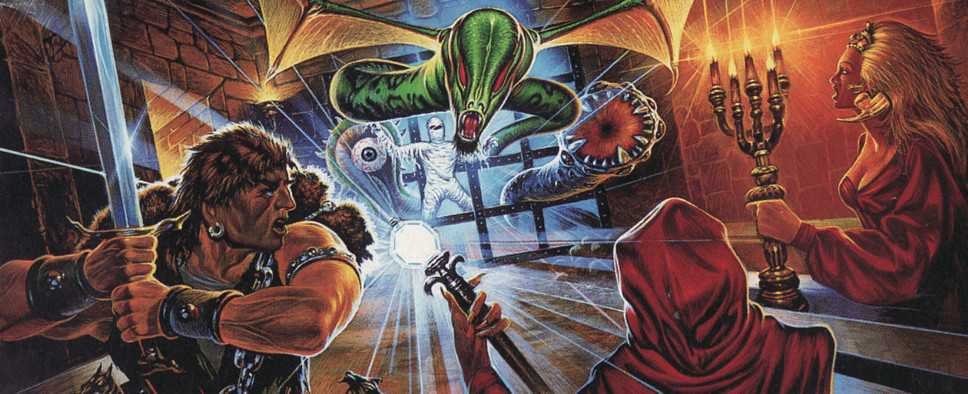Deadly Sins of CRPG Design
-
Category: News ArchiveHits: 3691

In other words, there is plenty to pull from:
I hate no-fault life insurance! If there is no penalty, there is no risk, there is no fear — translate that to no excitement. The adrenaline actually surged a few times during play of the Wizardry series when I encountered a group of monsters that might defeat me. In Bard’s Tale II, death was so painless that I committed suicide several times because it was the most expedient way to return to the Adventurer’s Guild.
When you take the risk of loss out of the game, it might as well be a crossword puzzle. The loss of possessions in Ultima IV and the loss of constitution in Might and Magic were tolerable compromises. The undead status in Phantasie was very nice. Your character was unharmed except for the fact that no further advancement was possible. Penalties can be too severe, of course. In Shard of Spring, loss of one battle means all characters are permanently lost. Too tough.
Here Irby hits on one of the most fraught debates in CRPG design, stretching from the days of the original Wizardry to today: what should be the penalty for failure? There’s no question that the fact that you couldn’t save in the dungeon was one of the defining aspects of Wizardry, the game that did more than any other to popularize the budding genre in the very early 1980s. Exultant stories of escaping the dreaded Total Party Loss by the skin of one’s teeth come up again and again when you read about the game. Andrew Greenberg and Bob Woodhead, the designers of Wizardry, took a hard-line stance on the issue, insisting that the lack of an in-dungeon save function was fundamental to an experience they had carefully crafted. They went so far as to issue legal threats against third-party utilities designed to mitigate the danger.
Over time, though, the mainstream CRPG industry moved toward the save-often, save-anywhere model, leaving Wizardry’s approach only to a hardcore sub-genre known as roguelikes. It seems clear that the change had some negative effects on encounter design; designers, assuming that players were indeed saving often and saving everywhere, felt they could afford to worry less about hitting players with impossible fights. Yet it also seems clear that many or most players, given the choice, would prefer to avoid the exhilaration of escaping near-disasters in Wizardry in favor of avoiding the consequences of unescaped disasters. The best solution, it seems to me, is to make limited or unlimited saving a player-selectable option. Failing that, it strikes me as better to err on the side of generosity; after all, hardcore players can still capture the exhilaration and anguish of an iron-man mode by simply imposing their own rules for when they allow themselves to save. All that said, the debate will doubtless continue to rage.
...
Mapping is another area where the technical affordances of the earliest games had a major effect on their designs. The dungeon levels in most 8-bit CRPGs were laid out on grids of a consistent number of squares across and down; such a template minimized memory usage and simplified the programmer’s task enormously. Unrealistic though it was, it was also a blessing for mappers. Wizardry, a game that was oddly adept at turning its technical limitations into player positives, even included sheets of graph paper of exactly the right size in the box. Later games like Dungeon Master, whose levels sprawl everywhere, run badly afoul of the problem Irby describes above — that of maps “running off the edge of the paper.” In the case of Dungeon Master, it’s the one glaring flaw in what could otherwise serve as a masterclass in designing a challenging yet playable dungeon crawl.
I don’t like it when a program doesn’t take advantage of my second disk drive, and I would feel that way about my printer if I had one. I don’t like junk magic (spells you never use), and I don’t like being stuck forever with the names I pick on the spur of the moment. A name that struck my fancy one day may not on another.
Another problem similar to “junk magic” that only really began to surface around the time that Irby was writing this letter is junk skills. Wasteland is loaded with skills that are rarely or never useful, along with others that are essential, and there’s no way for the new player to identify which are which. It’s a more significant problem than junk magic usually is because you invest precious points into learning and advancing your skills; there’s a well-nigh irreversible opportunity cost to your choices. All of what we might call the second generation of Interplay CRPGs, which began with Wasteland, suffer at least somewhat from this syndrome. Like the sprawling dungeon levels in Dungeon Master, it’s an example of the higher ambitions and more sophisticated programming of later games impacting the end result in ways that are, at best, mixed in terms of playability.
I suppose you are wondering why I play these stupid games if there is so much about them I don’t like. Actually, there are more things I do like, particularly when compared to watching Gilligan’s Island or whatever the current TV fare is. I suppose it would be appropriate to mention a few of the things I do like.

